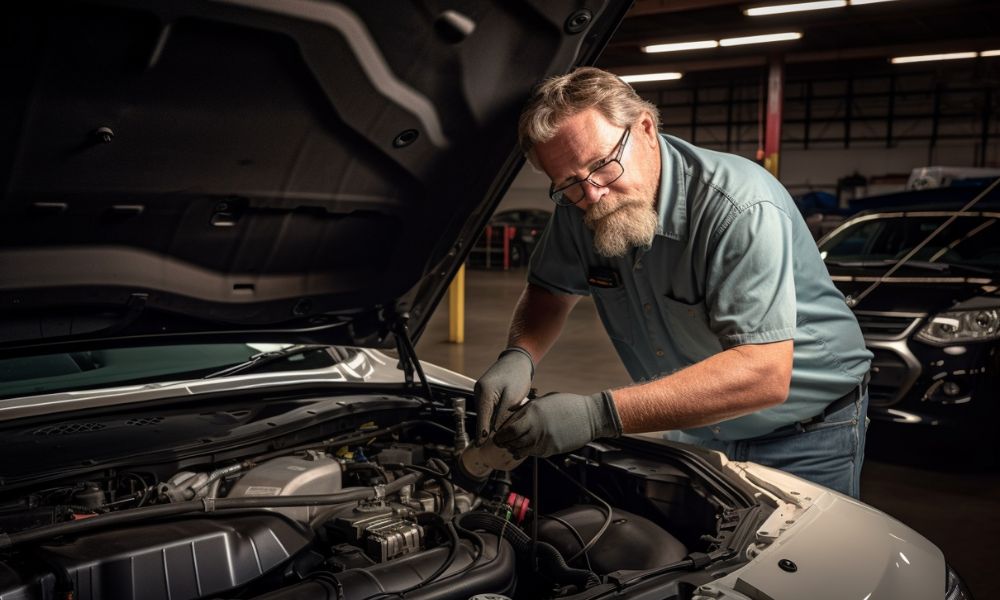
What to Look for When Buying a Rebuilt Title Car
TABLE OF CONTENTS
When considering the purchase of a rebuilt title car, it is crucial to conduct a thorough inspection to uncover any hidden damage or substandard repairs. Identifying potential issues before you buy can save you from costly repairs and headaches down the road. Read on for our guide to inspecting rebuilt title cars, focusing on common areas to examine for hidden damage.
To make life easier, we've also created a exhaustive 31 step car inspection form and checklist PDF covering each item mentioned below. By paying a qualified mechanic to fill it out, you can record a snapshot of the condition for all major components in one place. It may serve as a useful piece of documentation for buying negotiations or sales disclosures, and potentially to insurers when seeking coverage. For the non-completionists, there's also a simpler version of the same document; a condensed version with 20 inspection points.
KEY TAKEAWAYS
- 1
A thorough inspection of a rebuilt title car, including the body, frame, mechanical components, and electrical system, is crucial for uncovering hidden damage or substandard repairs.
- 2
An exhaustive checklist with 31 inspection points can serve as a helpful guide for assessing the condition of all major vehicle components and documenting findings.
- 3
Hiring a certified mechanic for a professional pre-purchase inspection provides an added layer of assurance and expert insight into the vehicle's overall condition.
Body and Frame Inspection
Panel gaps and alignment
Inspect the vehicle for uneven panel gaps or misaligned body parts, which may indicate poor repair work or underlying frame damage.
Paint quality and consistency
Look for color inconsistencies, uneven paint texture, or signs of overspray, which can suggest the car has undergone repairs that were not adequately disclosed or documented.
Signs of rust or corrosion
Check for rust or corrosion, particularly in areas that are prone to water accumulation or were previously damaged. Rust can compromise the structural integrity of the vehicle and lead to costly repairs.
Undercarriage examination
Inspect the undercarriage for signs of damage, such as bent or cracked components, which may indicate previous accidents or substandard repairs.
Mechanical Inspection
Engine and transmission
Examine the engine and transmission for leaks, unusual noises, or signs of damage. Request a compression test and a scan of the car's diagnostic trouble codes to assess the engine's health.
Clutch and transmission linkage (for manual transmissions)
Test the clutch operation and inspect the transmission linkage for signs of wear or damage. Issues with these components can affect the smoothness and reliability of gear shifts.
Belts and hoses
Check the condition of the serpentine belt, timing belt (if applicable), and other hoses for signs of wear, cracks, or fraying. Worn belts and hoses can lead to sudden failures and expensive repairs.
HVAC system
Test the heating, ventilation, and air conditioning system to ensure proper operation. Inadequate heating or cooling may indicate issues with the HVAC components or an underlying problem with the vehicle's electrical system.
Wipers and washer system
Check the windshield wipers and washer system for proper operation. Damaged or worn wipers can compromise visibility during inclement weather.
Fuel and Fluid Inspection
Fluid levels and quality
Check the quality and levels of engine oil, transmission fluid, brake fluid, and coolant. Dark or discolored fluids may indicate neglect or potential mechanical issues.
Cooling system
Inspect the radiator, hoses, and coolant reservoir for signs of leaks or damage. A compromised cooling system can lead to engine overheating and costly repairs.
Fuel system
Evaluate the condition of the fuel tank, fuel lines, and fuel pump. Leaks or damage in the fuel system can pose a safety hazard and affect the vehicle's performance.
Exhaust system
Examine the exhaust system for leaks, rust, or damage. Listen for unusual noises or vibrations that may indicate a problem with the exhaust components.
Emission control system
Inspect the catalytic converter, oxygen sensors, and other emission control components. Faulty emission control systems can lead to poor performance, reduced fuel efficiency, and failed emissions tests.
Suspension, Steering, and Drivetrain Inspection
Drivetrain components
Check the drivetrain, including the driveshaft, axles, and differentials, for signs of wear or damage. Problems with these components can affect the vehicle's stability and handling.
Suspension and steering components
Assess the condition of the suspension and steering systems, including bushings, ball joints, and tie rods. Damaged or worn components can affect handling, stability, and overall safety.
Power steering system
Inspect the power steering pump, hoses, and fluid reservoir for signs of leaks or damage. Malfunctioning power steering components can lead to increased steering effort and compromised handling.
Bushings and mounts
Inspect the engine and transmission mounts, as well as other rubber bushings in the suspension system, for signs of wear or deterioration. Worn mounts and bushings can cause vibrations, noise, and handling issues.
CV joints and boots (for front-wheel or all-wheel drive vehicles)
Inspect the CV joints and rubber boots for signs of wear, cracks, or leaking grease. Damaged CV joints can cause vibrations, clicking noises, and eventually lead to drivetrain failure.
Wheels and Brakes Inspection
Brake system
Inspect the brake system, including rotors, calipers, and brake lines, for signs of wear or damage. Poorly functioning brakes can compromise the vehicle's safety.
Tires and wheels
Check the tires for uneven wear, which may indicate alignment issues or suspension damage. Inspect the wheels for any signs of damage, such as cracks or bends, that could compromise their integrity.
Wheel bearings
Listen for any unusual noises or grinding sounds while driving, which could indicate worn wheel bearings. Worn bearings can negatively impact the vehicle's handling and lead to more severe problems if left unaddressed.
Electrical System Inspection
Wiring and connectors
Check the vehicle's wiring for frayed, damaged, or corroded connections, which may cause intermittent electrical issues or potential safety hazards.
Lights and accessories
Test all lights, including headlights, taillights, and turn signals, as well as accessories like the audio system, power windows, and air conditioning. Malfunctioning components may suggest electrical problems or incomplete repairs.
Battery and charging system
Inspect the battery, alternator, and starter for signs of wear or damage. A malfunctioning charging system can lead to battery drain and leave you stranded.
Interior and Safety Features Inspection
Dashboard warning lights
Start the vehicle and observe the dashboard warning lights. Ensure that no warning lights remain illuminated after the initial startup, which may indicate underlying issues with the vehicle's systems.
Airbags and seatbelts
Inspect the airbags and seatbelt systems to ensure they are functioning correctly and have not been tampered with or improperly re-installed after an accident.
Locks and security system
Test the door locks, trunk latch, and security system to ensure they are functioning correctly. Malfunctioning locks or security features can pose safety and theft risks.
Water damage
Examine the interior for signs of water damage, such as mold, mildew, or a musty odor, which can occur in flood-damaged vehicles or those with poorly repaired leaks.
Glass and seals
Check the windshield, windows, and sunroof for cracks or chips. Inspect the seals around the doors, windows, and sunroof for signs of water intrusion, which can cause interior damage and mold growth.
Performance during test drive
Pay attention to the vehicle's overall performance during a test drive. Assess the acceleration, braking, steering, and suspension for any unusual behavior or issues.
Professional Pre-Purchase Inspection
While a visual inspection is essential, hiring a certified mechanic to conduct a professional pre-purchase inspection provides an additional layer of assurance. A qualified mechanic can identify issues that may not be immediately apparent and provide expert insight into the vehicle's overall condition.
Conclusion
Thoroughly inspecting a rebuilt title car for hidden damage is crucial for making a wise decision and avoiding potential pitfalls. By examining the body, frame, mechanical components, electrical system, and interior, you can better assess the quality of the vehicle and its repairs. Ultimately, enlisting the help of a professional mechanic for a pre-purchase inspection can provide valuable peace of mind and help ensure a successful purchase.
TABLE OF CONTENTS


Trying to find the best insurance?
We'll help you find the policy that offers the best value for your situation.
Further Reading

Navigating the Digital Insurance Landscape Considerations
A look at the immense value and high customer lifetime potential within the insurance sector.
Read article

When is Term Life Insurance Worth it?
Decide if term life's advantages are worth it: compare whole vs term life insurance, assess top term providers, and delve into in-depth reviews.
Read article

Insurance Binder: Bridging Between Coverage and Confirmation
From car loans to rental properties, insurance binders are required in a variety of situations. Discover the ins and outs of these essential documents.
Read article

Haven Life Review: Providing Prudent and Protective Policies
Uncover the benefits and drawbacks of Haven Life's term insurance policies, along with eligibility details, pricing, and customer feedback..
Read article
Start Comparing Quotes
Search from our learning center to learn everything from how to easily switch your car insurance to the ins and outs of home insurance.
Fill out just one form and get multiple quotes!


